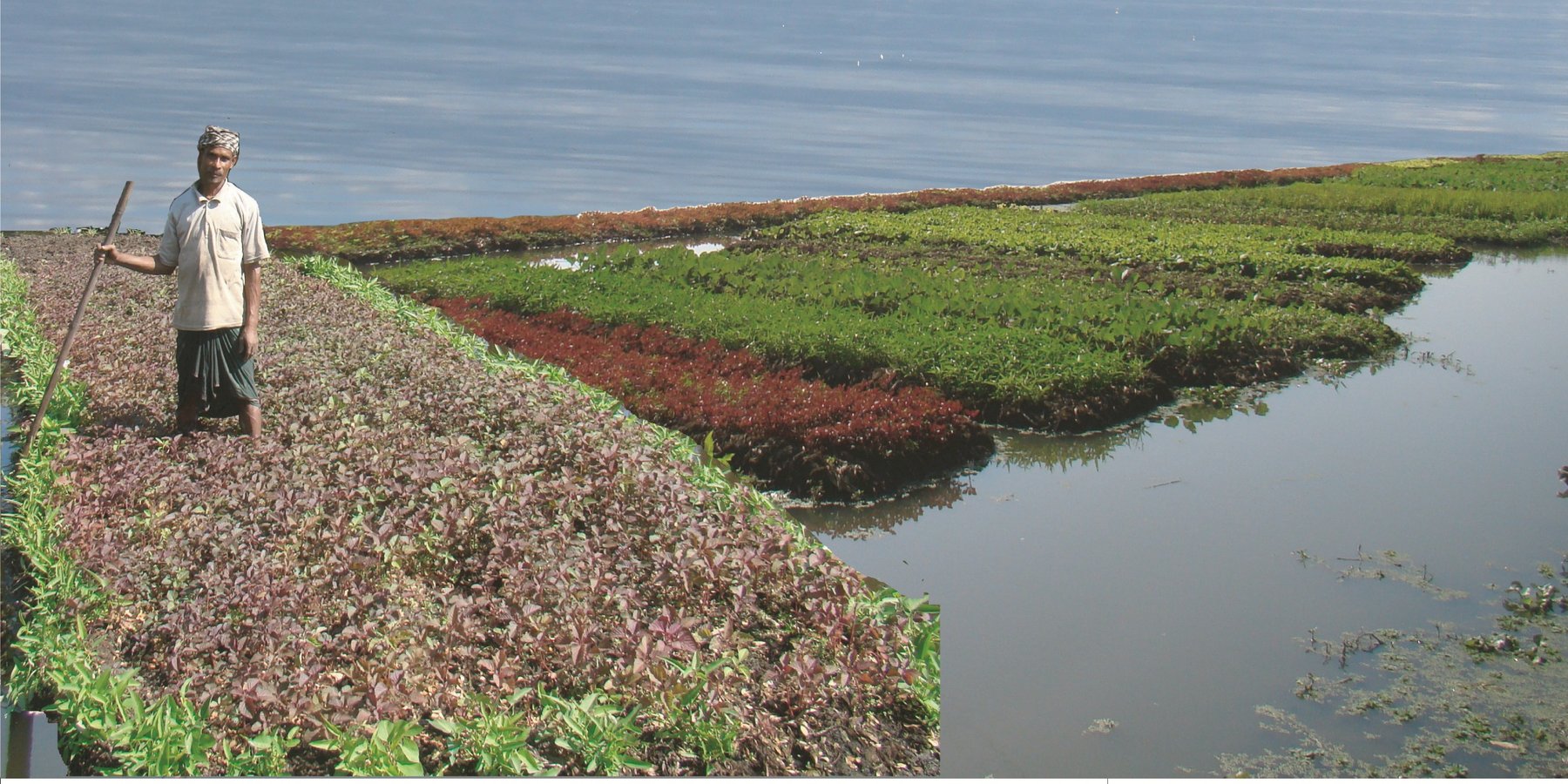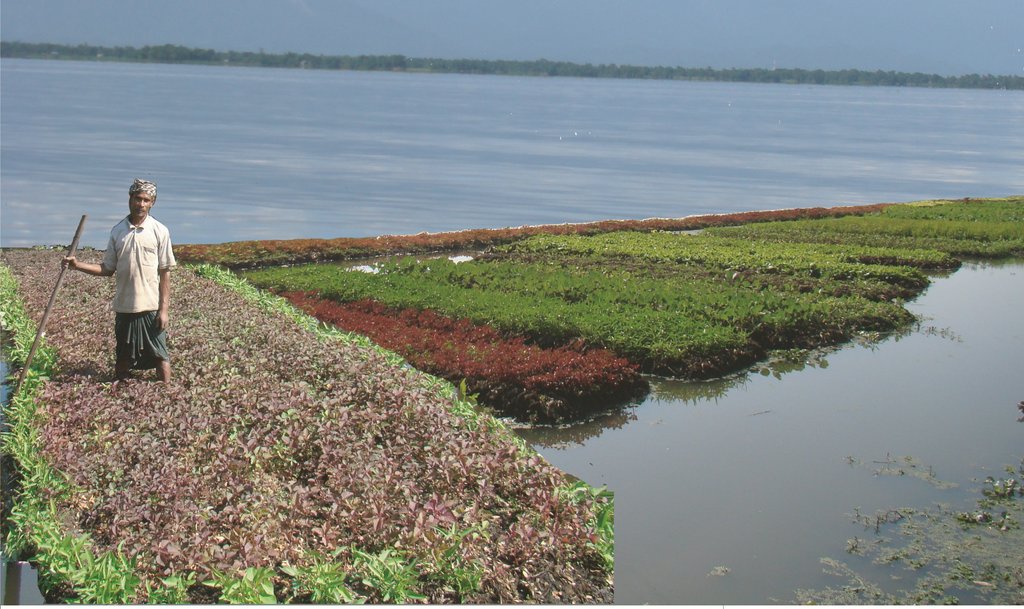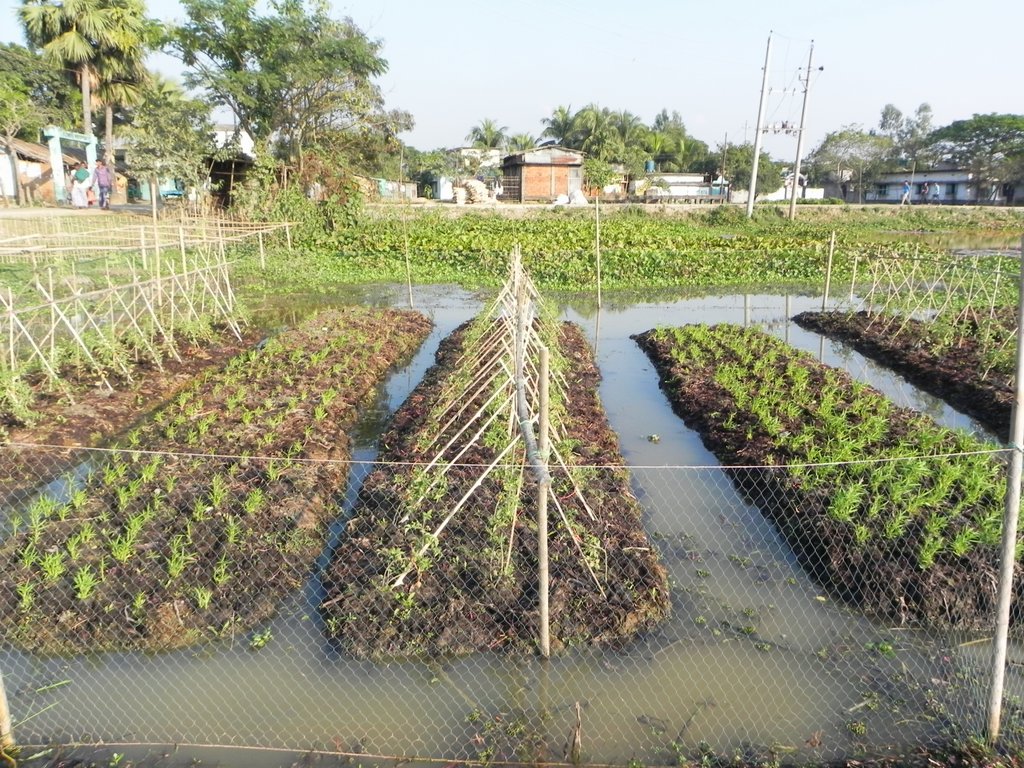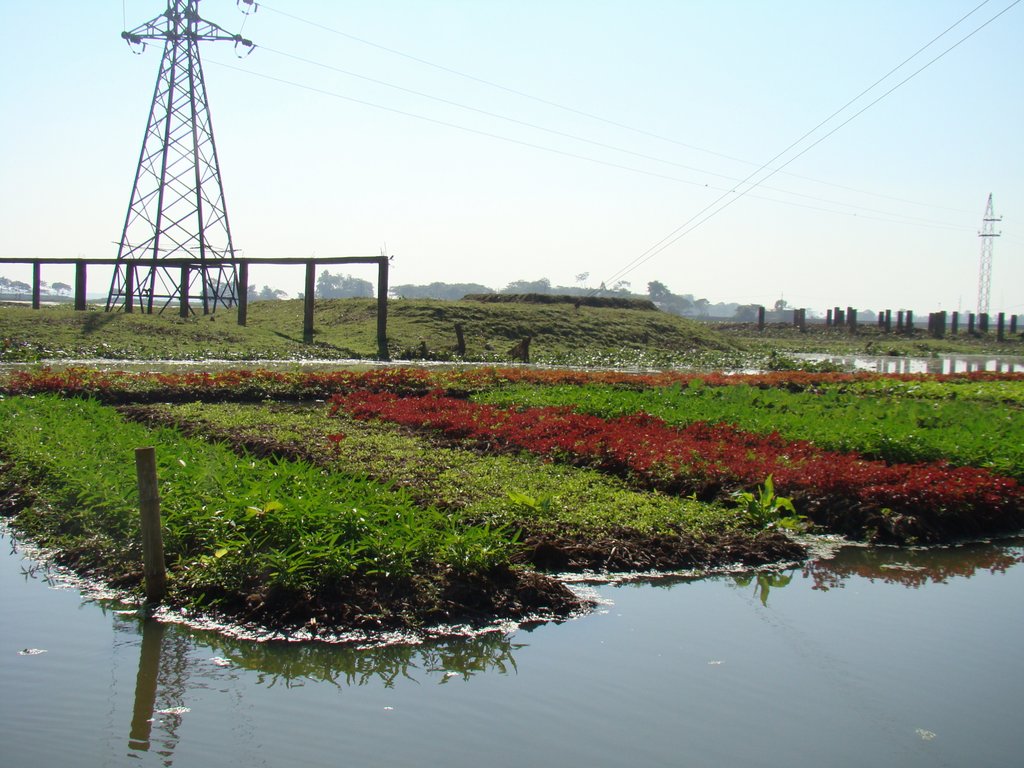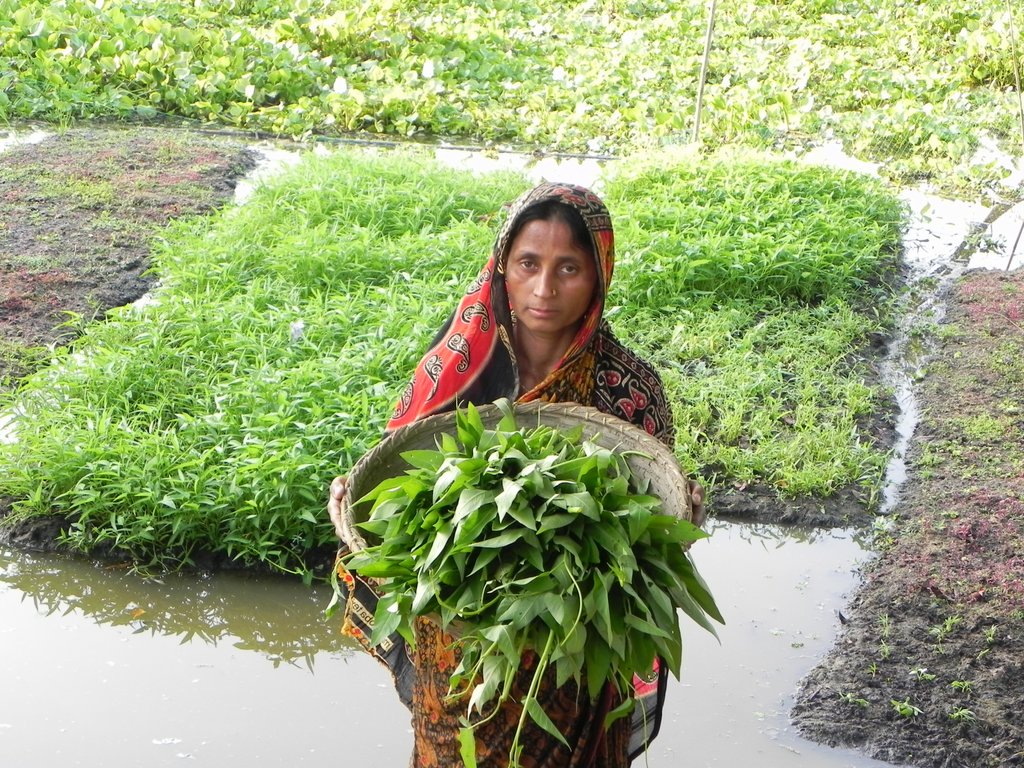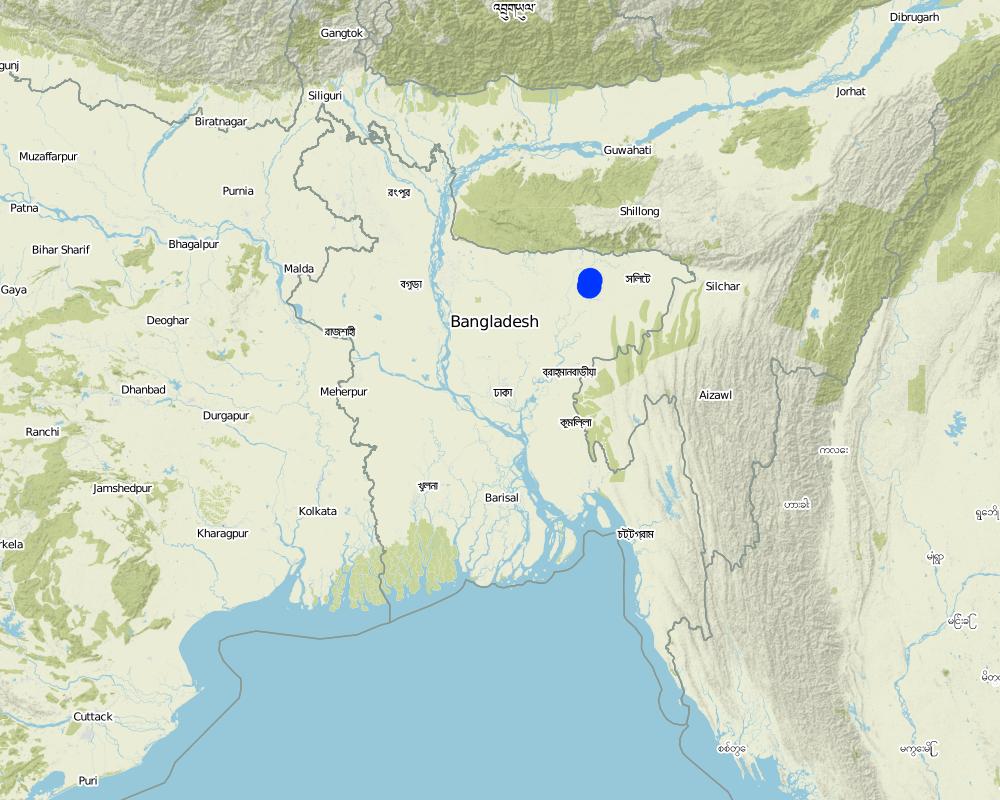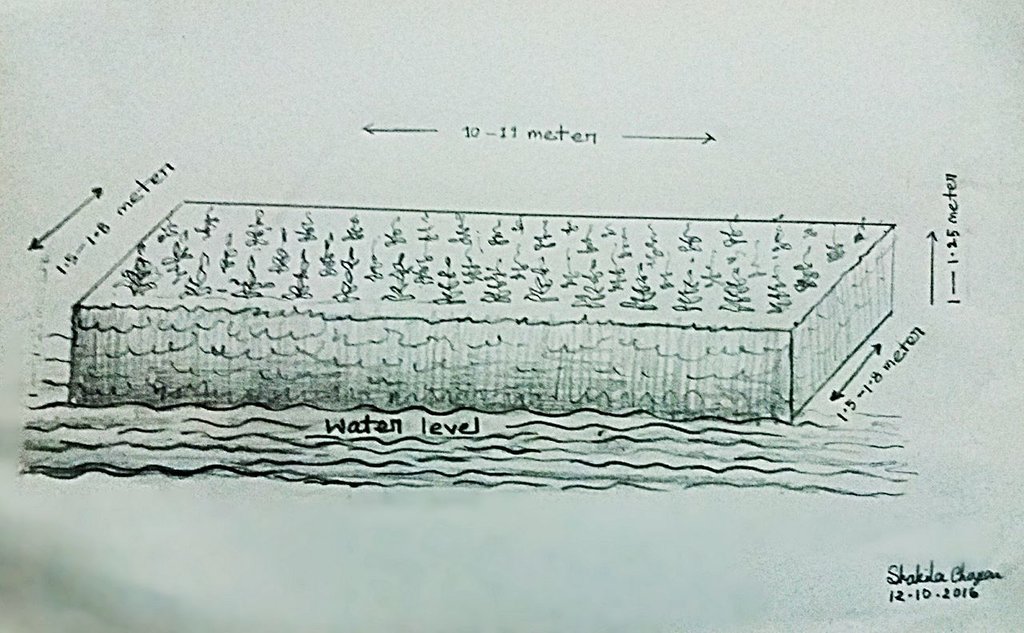Floating Garden [บังกลาเทศ]
- ผู้สร้างสรรค์:
- การอัพเดท:
- ผู้รวบรวม: Shamim Ahamed
- ผู้เรียบเรียง: Eveline Studer
- ผู้ตรวจสอบ: Alexandra Gavilano, Alvin Chandra
"Baira" or "Dhap", floating bed
technologies_620 - บังกลาเทศ
ดูส่วนย่อย
ขยายทั้งหมด ย่อทั้งหมด1. ข้อมูลทั่วไป
1.2 รายละเอียดที่ติดต่อได้ของผู้รวบรวมและองค์กรที่เกี่ยวข้องในการประเมินและการจัดเตรียมทำเอกสารของเทคโนโลยี
วิทยากรหลัก
ผู้เชี่ยวชาญ SLM:
Hasan Md. Zahid
+880 2 55052051-3 / +880 1716388648
zahid.hasan@helveas.org / zahidforestry@gmail.com
HELVETAS Swiss Intercooperation
House-13/A NE (K), Road-83, Gulshan-2, Dhaka, Post code-1212, Bangladesh
บังกลาเทศ
ชื่อของโครงการซึ่งอำนวยความสะดวกในการทำเอกสารหรือการประเมินเทคโนโลยี (ถ้าเกี่ยวข้อง)
Book project: where people and their land are safer - A Compendium of Good Practices in Disaster Risk Reduction (DRR) (where people and their land are safer)ชื่อขององค์กรซึ่งอำนวยความสะดวกในการทำเอกสารหรือการประเมินเทคโนโลยี (ถ้าเกี่ยวข้อง)
HELVETAS (Swiss Intercooperation)1.3 เงื่อนไขการใช้ข้อมูลที่ได้บันทึกผ่านทาง WOCAT
วันที่เก็บรวบรวมข้อมูล(ภาคสนาม) :
05/10/2016
ผู้รวบรวมและวิทยากรหลักยอมรับเงื่อนไขเกี่ยวกับการใช้ข้อมูลที่ถูกบันทึกผ่านทาง WOCAT:
ใช่
1.4 การเปิดเผยเรื่องความยั่งยืนของเทคโนโลยีที่ได้อธิบายไว้
เทคโนโลยีที่ได้อธิบายไว้นี้เป็นปัญหาของความเสื่อมโทรมโทรมของที่ดินหรือไม่ จึงไม่ได้รับการยอมรับว่าเป็นเทคโนโลยีเพื่อการจัดการที่ดินอย่างยั่งยืน:
ไม่ใช่
แสดงความคิดเห็น:
Context specific environmentally friendly technology
2. การอธิบายลักษณะของเทคโนโลยี SLM
2.1 การอธิบายแบบสั้น ๆ ของเทคโนโลยี
คำจำกัดความของเทคโนโลยี:
Floating Garden is a traditional technology, practiced in the southern parts of Bangladesh locally called “Baira” or “Dhap”. The technology allows producing crops, vegetables and seedlings in areas where farming land is scarce and where the land is flodded or water logged for more than six months in a year.
2.2 การอธิบายแบบละเอียดของเทคโนโลยี
คำอธิบาย:
Floating gardensa are a traditional practice in south central districts of Bangladesh since long time, and has been promoted by government extension agency and development organizations in different parts of the country with technical improvements. With this technology, crops (mainly vegetables) are cultivated on floating garden beds in areas where the land inundated for more than six months in a year.
Establishment:
The basic input and main raw material to prepare the floating garden bed are water hyacinths (Eichhornia crassipes). In some cases bamboo sticks are also used to make the floating beds more resistant. The floating gardens are of different size, with a standard size per bed during preparation of 1.5 - 1.8 meter wide, 10 -11 meter long and 1 - 1.3 meter above water level. However, considering local context- such as wave action, size of water body, presence of a wetland - the bed size may vary, also depending on whether compost is added on the top. The establishment of the floating gardens are very cheap in terms of raw material and require mainly human manual labour for its establishment, without material costs for maintenance.
The garden can be used for two purposes: for vegetable production and for vegetable seedling production.
In water logged areas (where water remains for the whole year) floating beds are mainly used for vegetable production. Almost any type of vegetables can be grown in the floating bed. Production of leafy vegetables proofed to be most profitable. In addition, all types of vegetable seedlings and rice seedlings can produced in floating garden based on demand. In other areas, which are only inundated temporarily, floating garden can be used for both vegetable and seedling production. In this second case seedlings can be transfered from the garden to the fields on the main land immediately after receding of the water. This practice can save 2 to 3 weeks time of vegetable or rice production in winter season. This is a crucial advantage considering the trend to shorter growing periods due to unpredictable early spring rains.
A key advantage of floating gardening is the fact that heavy rainfalls usually do not have any negative effect on culture of the floating gardens, which are a highly effective and beneficial risk reduction and climate change mitigation technology. Floating gardens can further contribute to food security and improved nutrition for poor households, and it is a source for additional income by making use of cheap and abundant local input resources. Different NGOs improved and promoted this technology in north-west and north-east parts of Bangladesh since 2000. Since 2011 also the public agricultural extension agencies promote this technology.
As an overall goal this technology aims at protecting people’s assets for agricultural production from damages due to seasonal floods and provide options for alternative income resources. The floating garden technology is designed as measure to protect effectively from yearly floods. It might not be robust enough for extreme events with heavy storms and waves. Smaller repairing can be done by the owners themselves. In case of major damages the beds can be replaced by new ones, since the investment costs are very low. In the shallow areas the floating beds may become ordinary garden beds or fields during dry season.
2.3 รูปภาพของเทคโนโลยี
2.4 วีดีโอของเทคโนโลยี
ความคิดเห็น/อธิบายสั้นๆ:
This video was developed for the capitalization of practical experience and instructive training materials. The short movie describes step by step the establishment and the benefits of the floating gardens. In a short interview governmental and other local partners share their positive experience of the technology and describe how the technology is mainstreamed by Government agencies.
The video is available online with following link: https://youtu.be/AK_qTm2pUsw
วันที่:
29/02/2012
สถานที่:
Sunamganj, Bangladesh
ชื่อผู้ถ่ายวีดีโอ:
HELVETAS Swiss Intercooperation
ความคิดเห็น/อธิบายสั้นๆ:
The video documentary was prepared to capitalise and diseminate the experience of the Floating Gardens as an innovative technology for vegetable cultivation in wetlands.
วันที่:
01/06/2012
สถานที่:
Sunamganj, Bangladesh
ชื่อผู้ถ่ายวีดีโอ:
HELVETAS Swiss Intercoopartion
2.5 ประเทศภูมิภาค หรือสถานที่ตั้งที่เทคโนโลยีได้นำไปใช้และได้รับการครอบคลุมโดยการประเมินนี้
ประเทศ:
บังกลาเทศ
ภูมิภาค/รัฐ/จังหวัด:
Sylhet division, Sunamganj district
ข้อมูลจำเพาะเพิ่มเติมของสถานที่ตั้ง :
Paschim Pagla, Patharia and Shimulbak unions under South Sunamganj sub-district, Charnarchar and Rajanagar unions under Derai sub-district
แสดงความคิดเห็น:
More than 1000 floating beds have been prepared in 8 sub-districts of Sunamganj district in northeastern Bangladesh and documented accordingly. HELVETAS supported government agencies (District Administration and Department of Agricultural Extension-DAE) to document and promote the technology further.
Map
×2.6 วันที่การดำเนินการ
ถ้าไม่รู้ปีที่แน่นอน ให้ระบุวันที่โดยประมาณ:
- น้อยกว่า 10 ปี (ไม่นานนี้)
2.7 คำแนะนำของเทคโนโลยี
ให้ระบุว่าเทคโนโลยีถูกแนะนำเข้ามาอย่างไร:
- ทางโครงการหรือจากภายนอก
ความคิดเห็น (ประเภทของโครงการ เป็นต้น) :
The technology was first piloted through implementation of “Livelihoods, Empowerment and Agroforestry (LEAF)” project. Later on, the technology was expanded through implementation of “Agricultural Innovation for Eliminating Extreme Poverty” (AIEEP 2009-2012) and through Unnoti -Prosperity in Haor project (2013-2016).
3. การจัดประเภทของเทคโนโลยี SLM
3.1 วัตถุประสงค์หลักของเทคโนโลยี
- ปรับปรุงการผลิตให้ดีขึ้น
- ลดความเสี่ยงของภัยพิบัติ
- ปรับตัวเข้ากับการเปลี่ยนแปลงภูมิอากาศของโลก สภาพภูมิอากาศที่รุนแรงและผลกระทบ
- สร้างผลกระทบทางด้านเศรษฐกิจที่เป็นประโยชน์
- สร้างผลกระทบทางด้านสังคมที่เป็นประโยชน์
- improve household food security / nutrition
3.2 ประเภทของการใช้ที่ดินในปัจจุบันที่ได้นำเทคโนโลยีไปใช้

พื้นที่ปลูกพืช
- การปลูกพืชล้มลุกอายุปีเดียว
พืชหลัก (พืชเศรษฐกิจและพืชอาหาร):
Vegetables and seedlings

ทางน้ำ แหล่งน้ำ พื้นที่ชุ่มน้ำ
- หนองบึง พื้นที่ชุ่มน้ำ
ผลิตภัณฑ์หลักหรือบริการ:
Vegetable and Seedling
ถ้าการใช้ที่ดินมีการเปลี่ยนแปลงเนื่องมาจากการนำเทคโนโลยีไปปฏิบัติใช้ ให้ระบุการใช้ที่ดินก่อนนำเทคโนโลยีไปปฏิบัติใช้:
earlier these wetland areas were mainly fallow (not used for any productive purpose). During monsoon season, the waterbodies naturally count on fish reserves, which are captures by local farmers including landless poor. Water hyacinth of these wetlands were partially used as fodder, though most of it was decomposed naturally without use.
3.3 ข้อมูลเพิ่มเติมเกี่ยวกับการใช้ที่ดิน
อื่นๆ (เช่น หลังจากน้ำท่วม):
- post-flooding
แสดงความคิดเห็น:
Floating gardens are prepared on the water body, hence can absorb sufficient water without additional irrigation.
จำนวนของฤดูเพาะปลูกต่อปี:
- 2
ระบุ:
Winter and early Summer
3.4 กลุ่ม SLM ที่ตรงกับเทคโนโลยีนี้
- การปรับปรุงดิน / พืชคลุมดิน
- การป้องกัน / การจัดการพื้นที่ชุ่มน้ำ
- สวนครัว
3.5 กระจายตัวของเทคโนโลยี
ระบุการกระจายตัวของเทคโนโลยี:
- ใช้ ณ จุดที่เฉพาะเจาะจงหรือเน้นไปยังบริเวณพื้นที่ขนาดเล็ก
3.6 มาตรการ SLM ที่ประกอบกันเป็นเทคโนโลยี

มาตรการจัดการพืช
- A5: การจัดการเมล็ดพันธุ์ การปรับปรุงพันธุ์

มาตรการอนุรักษ์ด้วยโครงสร้าง
- S11: อื่น ๆ

มาตรการอนุรักษ์ด้วยการจัดการ
- M1: การเปลี่ยนรูปแบบของการใช้ประโยชน์ที่ดิน
แสดงความคิดเห็น:
floating beds, which are adapted to changing water levels (floods).
change of land/water management from pure wetlands to gardens.
3.7 รูปแบบหลักของการเสื่อมโทรมของที่ดินที่ได้รับการแก้ไขโดยเทคโนโลยี

การเสื่อมโทรมของน้ำ
- Hs (Change in quantity of surface water): การเปลี่ยนแปลงปริมาณของน้ำที่ผิวดิน
แสดงความคิดเห็น:
More frequent and severe seasonal floodings
3.8 การป้องกัน การลดลง หรือการฟื้นฟูความเสื่อมโทรมของที่ดิน
ระบุเป้าหมายของเทคโนโลยีกับความเสื่อมโทรมของที่ดิน:
- ลดความเสื่อมโทรมของดิน
- ปรับตัวกับสภาพความเสื่อมโทรมของที่ดิน
แสดงความคิดเห็น:
The technology is used to adapt to natural seasonal flooding, to prevent damages caused by floods by using wet lands for crop production.
4. ข้อมูลจำเพาะด้านเทคนิค กิจกรรมการนำไปปฏิบัติใช้ ปัจจัยนำเข้า และค่าใช้จ่าย
4.1 แบบแปลนทางเทคนิคของเทคโนโลยี
4.2 ข้อมูลจำเพาะด้านเทคนิคและการอธิบายแบบแปลนทางเทคนิค
• Dimensions: The floating beds are of different size. Standard size at the time of preparation 1.5 - 1.8 meter wide, 10-11 meter long and 1.0-1.3 meter height.
• Floating beds should not cover more than 30% area of the respective water body (wetland area) in order to keep enabling environment for other aquatic resources (e.g. fishes).
• Construction material used: The basic and main ingredient/material for the preparation of the floating garden are water hyacinths (Eichhornia crassipes). In some cases, bamboo sticks are also used to increase its resistance. If available, composts may be applied on the top of floating beds, though not compulsory.
4.3 ข้อมูลทั่วไปเกี่ยวกับการคำนวณปัจจัยนำเข้าและค่าใช้จ่าย
ให้ระบุว่าค่าใช้จ่ายและปัจจัยนำเข้าได้รับการคำนวณอย่างไร:
- ต่อพื้นที่ที่ใช้เทคโนโลยี
ระบุขนาดและหน่วยพื้นที่:
1 decimal for 5 floating beds
ถ้าใช้หน่วยพื้นที่ตามท้องถิ่น ให้ระบุตัวแปลงค่า เช่น 1 เฮกตาร์ :
1 hectare = 247 decimals
อื่นๆ หรือสกุลเงินประจำชาติ (ระบุ):
BDT
ระบุค่าเฉลี่ยของค่าจ้างในการจ้างแรงงานต่อวัน:
1 man-day cost BDT 300 (USD 3.85)
4.4 กิจกรรมเพื่อการจัดตั้ง
| กิจกรรม | ประเภทของมาตรการ | ช่วงเวลาดำเนินการ | |
|---|---|---|---|
| 1. | Bed preparation (by hired labour) | ด้วยโครงสร้าง | August-September |
| 2. | Seeding, care and maintenance, harvesting | จัดการพืช | September-March |
แสดงความคิดเห็น:
After full harvesting of vegetable in March, the bed (decomposed water hyacinth) can be used as organic compost for other crops in cultivable land.
4.5 ค่าใช้จ่ายของปัจจัยนำเข้าที่จำเป็นสำหรับการจัดตั้ง
| ปัจจัยนำเข้า | หน่วย | ปริมาณ | ค่าใช้จ่ายต่อหน่วย | ค่าใช้จ่ายทั้งหมดต่อปัจจัยนำเข้า | %ของค่าใช้จ่ายที่ก่อให้เกิดขึ้นโดยผู้ใช้ที่ดิน | |
|---|---|---|---|---|---|---|
| แรงงาน | Hired labour cost for bed establishment | persons day | 10.0 | 300.0 | 3000.0 | |
| แรงงาน | Bed management cost (seeing, care, harvest ect.) | persons day | 90.0 | 300.0 | 27000.0 | 100.0 |
| วัสดุด้านพืช | Seeds per year | kg | 25.0 | 100.0 | 2500.0 | 100.0 |
| วัสดุสำหรับก่อสร้าง | Bamboo | bamboo quantity | 2.0 | 100.0 | 200.0 | |
| วัสดุสำหรับก่อสร้าง | Rope and lubricants | lumpsum | 1.0 | 250.0 | 250.0 | |
| ค่าใช้จ่ายทั้งหมดของการจัดตั้งเทคโนโลยี | 32950.0 | |||||
4.6 การบำรุงรักษาสภาพหรือกิจกรรมที่เกิดขึ้นเป็นประจำ
แสดงความคิดเห็น:
No maintenance required
4.7 ค่าใช้จ่ายของปัจจัยนำเข้าและกิจกรรมที่เกิดขึ้นเป็นประจำที่ต้องการการบำรุงรักษา (ต่อปี)
แสดงความคิดเห็น:
No specific maintenance costs during the year/season required. Small repairments are part of the labour costs of agronomic mesures to be done in paralele with care work.
4.8 ปัจจัยสำคัญที่สุดที่มีผลกระทบต่อค่าใช้จ่าย
ปัจจัยสำคัญที่สุดที่มีผลกระทบต่อค่าใช้จ่ายต่างๆ:
In case the inputs, mainly water hyacinths, are not available at the selected sites, this increases the material and/or labour costs for hyacinths to be transported from distant locations.
All indicated costs refer to yearly costs, since the beds ususally have to be restablished every year.
5. สิ่งแวดล้อมทางธรรมชาติและของมนุษย์
5.1 ภูมิอากาศ
ฝนประจำปี
- < 250 ม.ม.
- 251-500 ม.ม.
- 501-750 ม.ม.
- 751-1,000 ม.ม.
- 1,001-1,500 ม.ม.
- 1,501-2,000 ม.ม.
- 2,001-3,000 ม.ม.
- 3,001-4,000 ม.ม.
- > 4,000 ม.ม.
ระบุปริมาณน้ำฝนเฉลี่ยรายปี (ถ้ารู้) :หน่วย ม.ม.
3365.00
ข้อมูลจำเพาะ/ความคิดเห็นเรื่องปริมาณน้ำฝน:
The driest month is December, with 6 mm of rain. The greatest amount of precipitation occurs in June, with an average of 712 mm.
ระบุชื่อของสถานีตรวดวัดอากาศที่ใช้อ้างอิงคือ:
Sunamganj, Bangladesh (data source: www.en.climate-data.org)
เขตภูมิอากาศเกษตร
- ชื้น
The average annual temperature is 25.0 °C in Sunamganj.
5.2 สภาพภูมิประเทศ
ค่าเฉลี่ยความลาดชัน:
- ราบเรียบ (0-2%)
- ลาดที่ไม่ชัน (3-5%)
- ปานกลาง (6-10%)
- เป็นลูกคลื่น (11-15%)
- เป็นเนิน (16-30%)
- ชัน (31-60%)
- ชันมาก (>60%)
ธรณีสัณฐาน:
- ที่ราบสูง/ที่ราบ
- สันเขา
- ไหล่เขา
- ไหล่เนินเขา
- ตีนเนิน
- หุบเขา
ระดับความสูง:
- 0-100 เมตร
- 101-500 เมตร
- 501-1,000 เมตร
- 1,001-1,500 เมตร
- 1,501-2,000 เมตร
- 2,001-2,500 เมตร
- 2,501-3,000 เมตร
- 3,001-4,000 เมตร
- > 4,000 เมตร
ให้ระบุถ้าเทคโนโลยีได้ถูกนำไปใช้:
- บริเวณแอ่งบนที่ราบ (concave situations)
5.3 ดิน
(ถ้ามี) ให้แนบคำอธิบายเรื่องดินแบบเต็มหรือระบุข้อมูลที่มีอยู่ เช่น ชนิดของดิน ค่า pH ของดินหรือความเป็นกรดของดิน ความสามารถในการแลกเปลี่ยนประจุบวก ไนโตรเจน ความเค็ม เป็นต้น:
Not applicable for this technology as floating bed prepare on surface of water body
5.4 ความเป็นประโยชน์และคุณภาพของน้ำ
ระดับน้ำใต้ดิน:
ที่ผิวดิน
น้ำไหลบ่าที่ผิวดิน:
เกินพอ
คุณภาพน้ำ (ที่ยังไม่ได้บำบัด):
เป็นน้ำใช้เพื่อการเกษตรเท่านั้น (การชลประทาน)
ความเค็มของน้ำเป็นปัญหาหรือไม่:
ไม่ใช่
กำลังเกิดน้ำท่วมในพื้นที่หรือไม่:
ใช่
บ่อยครั้ง:
บ่อยครั้ง
ความคิดเห็นและข้อมูลจำเพาะเพิ่มเติมเรื่องคุณภาพและปริมาณน้ำ:
Each year seasonal monsoon flooding. However, early flash (pre monsoon flood) occur only every 3 years.
5.5 ความหลากหลายทางชีวภาพ
ความหลากหลายทางชนิดพันธุ์:
- ปานกลาง
ความหลากหลายของแหล่งที่อยู่:
- ปานกลาง
ความคิดเห็นและข้อมูลจำเพาะเพิ่มเติมของความหลากหลายทางชีวภาพ:
Water bodies are rich with diverse aquatic organisms
5.6 ลักษณะของผู้ใช้ที่ดินที่นำเทคโนโลยีไปปฏิบัติใช้
อยู่กับที่หรือเร่ร่อน:
- อยู่กับที่
แนวทางการตลาดของระบบการผลิต:
- ผสม (การเลี้ยงชีพ/ทำการค้า)
รายได้ที่มาจากนอกฟาร์ม:
- 10-50% ของรายได้ทั้งหมด
ระดับของความมั่งคั่งโดยเปรียบเทียบ:
- ยากจนมาก
- จน
เป็นรายบุคคล/ครัวเรือน:
- เป็นรายบุคคล/ครัวเรือน
- กลุ่ม/ชุมชน
ระดับของการใช้เครื่องจักรกล:
- งานที่ใช้แรงกาย
เพศ:
- หญิง
- ชาย
อายุของผู้ใช้ที่ดิน:
- ผู้เยาว์
- วัยกลางคน
5.7 พื้นที่เฉลี่ยของที่ดินที่เป็นเจ้าของหรือเช่าโดยผู้ใช้ที่ดินที่นำเทคโนโลยีไปปฏิบัติใช้
- < 0.5 เฮกตาร์
- 0.5-1 เฮกตาร์
- 1-2 เฮกตาร์
- 2-5 เฮกตาร์
- 5-15 เฮกตาร์
- 15-50 เฮกตาร์
- 50-100 เฮกตาร์
- 100-500 เฮกตาร์
- 500-1,000 เฮกตาร์
- 1,000-10,000 เฮกตาร์
- >10,000 เฮกตาร์
พิจารณาว่าเป็นขนาดเล็ก กลาง หรือขนาดใหญ่ (ซึ่งอ้างอิงถึงบริบทระดับท้องถิ่น):
- ขนาดเล็ก
5.8 กรรมสิทธิ์ในที่ดิน สิทธิในการใช้ที่ดินและสิทธิในการใช้น้ำ
สิทธิในการใช้น้ำ:
- เข้าถึงได้แบบเปิด (ไม่ได้จัดระเบียบ)
- รายบุคคล
แสดงความคิดเห็น:
The farmers establish floating gardens in public water body and in private water body (with verbal agreement of water body owners).
5.9 การเข้าถึงบริการและโครงสร้างพื้นฐาน
สุขภาพ:
- จน
- ปานกลาง
- ดี
การศึกษา:
- จน
- ปานกลาง
- ดี
ความช่วยเหลือทางด้านเทคนิค:
- จน
- ปานกลาง
- ดี
การจ้างงาน (เช่น ภายนอกฟาร์ม):
- จน
- ปานกลาง
- ดี
ตลาด:
- จน
- ปานกลาง
- ดี
พลังงาน:
- จน
- ปานกลาง
- ดี
ถนนและการขนส่ง:
- จน
- ปานกลาง
- ดี
น้ำดื่มและการสุขาภิบาล:
- จน
- ปานกลาง
- ดี
บริการด้านการเงิน:
- จน
- ปานกลาง
- ดี
6. ผลกระทบและสรุปคำบอกกล่าว
6.1 ผลกระทบในพื้นที่ดำเนินการ (On-site) จากการใช้เทคโนโลยี
ผลกระทบทางด้านเศรษฐกิจและสังคม
การผลิต
การผลิตพืชผล
แสดงความคิดเห็น/ระบุ:
crop production during rainy season becomes possible
พื้นที่สำหรับการผลิต
แสดงความคิดเห็น/ระบุ:
innundated fallow water bodies can be used for food production, which increases surface for production.
รายได้และค่าใช้จ่าย
รายได้จากฟาร์ม
แสดงความคิดเห็น/ระบุ:
People produce vegetable/seedlings and increase their cash income through selling of the production surplus in the market. It also provide food and additional nutrition support to the farm family. Consequently, poor farmer families increase their resilience to food insecurity and income fluctuation.
ความหลากหลายของแหล่งผลิตรายได้
แสดงความคิดเห็น/ระบุ:
Additional income for floating gardeners, which is particularly valuable for poor i.e. landless people.
ความเหลื่อมล้ำทางเศรษฐกิจ
จำนวนก่อน SLM:
0
หลังจาก SLM:
1
ภาระงาน
แสดงความคิดเห็น/ระบุ:
slight but no significant increase in workload for bed preparation, care and harvesting
ผลกระทบด้านสังคมวัฒนธรรมอื่น ๆ
ความมั่นคงด้านอาหาร / พึ่งตนเองได้
แสดงความคิดเห็น/ระบุ:
Vegetable production for home consumption contribute to households food security, which is particularly critical during rainiy season.
สถานการณ์ด้านสุขภาพ
แสดงความคิดเห็น/ระบุ:
Improved nutrition through household consumption of own vegetable production.
การใช้ที่ดิน / สิทธิในการใช้น้ำ
แสดงความคิดเห็น/ระบุ:
People establish floating garden on public water bodies or individual water bodies, based on a (verbal) agreement and regulated by a free or rent.
โอกาสทางวัฒนธรรม
แสดงความคิดเห็น/ระบุ:
Increase aesthetic view of wetlands, water becomes valuable productive surface with plants and flowers.
SLM หรือความรู้เรื่องความเสื่อมโทรมของที่ดิน
แสดงความคิดเห็น/ระบุ:
Increased knowledge on disaster risk reduction technology, based on local resources and capacities adjusted to the situation of socially and economically disadvantaged groups.
สถานการณ์ของกลุ่มด้อยโอกาส ทางด้านสังคมและเศรษฐกิจ
แสดงความคิดเห็น/ระบุ:
Its an simple "self-help" technology, which proveds new income options particularly for most vulnerable. It can be replicated by disadvantaged groups them-selfs landless and increases cohesion among the poor and very poor community members.
ผลกระทบด้านนิเวศวิทยา
ความหลากหลายทางชีวภาพของพืชและสัตว์
การปกคลุมด้วยพืช
แสดงความคิดเห็น/ระบุ:
floating gardens increase vegetation coverage on the water surface
มวลชีวภาพ/เหนือดินชั้น C
แสดงความคิดเห็น/ระบุ:
the material of old floating gardens, usualy at the end of the rainy season, are used as compost/ fertiliser for crop land.
ความหลากหลายทางชีวภาพของสัตว์
แสดงความคิดเห็น/ระบุ:
With the floating gardens there are less water hyacinths spread over the surface, which increases sunlight and oxygen on the water. Hence, this contributes to good conditions for the growth of fish and other aquatic resources.
ลดความเสี่ยงของภัยพิบัติ
ผลกระทบจากน้ำท่วม
แสดงความคิดเห็น/ระบุ:
Negative impacts due to floods, such as damages and limited production can be substantially reduced with this technology, which increases production and income during flooding period.
6.2 ผลกระทบนอกพื้นที่ดำเนินการ (Off-site) จากการใช้เทคโนโลยี
ความเสียหายต่อพื้นที่เพาะปลูกของเพื่อนบ้าน
จำนวนก่อน SLM:
0
หลังจาก SLM:
1
แสดงความคิดเห็น/ระบุ:
reduce/protect wave action and decrease soil erosion of the adjacent/raised land.
damage by wave erosion
แสดงความคิดเห็น/ระบุ:
The floating gardens reduce wave erosion on neighbours' fields, since the beds protect adjacent land and assets from soil erosion.
ความคิดเห็นเกี่ยวกับการประเมินผลกระทบ:
No specific research have been made on off-site and environmental impact of the floating garden technology.
6.3 การเผชิญและความตอบสนองของเทคโนโลยีต่อการเปลี่ยนแปลงสภาพภูมิอากาศที่ค่อยเป็นค่อยไป และสภาพรุนแรงของภูมิอากาศ / ภัยพิบัติ (ที่รับรู้ได้โดยผู้ใช้ที่ดิน)
สภาพรุนแรงของภูมิอากาศ (ภัยพิบัติ)
ภัยพิบัติจากน้ำ
| เทคโนโลยีมีวิธีการรับมืออย่างไร | |
|---|---|
| น้ำท่วมตามปกติ (แม่น้ำ) | ดี |
| น้ำท่วมฉับพลัน | ดีมาก |
สภาพรุนแรงของภูมิอากาศ (ภัยพิบัติ) อื่น ๆ
| อื่น ๆ (ระบุ) | เทคโนโลยีมีวิธีการรับมืออย่างไร |
|---|---|
| increasingly unpredictable start and duration of monsoon/rainy season, floods | ปานกลาง |
ผลลัพธ์ตามมาที่เกี่ยวข้องกับภูมิอากาศอื่น ๆ
ผลลัพธ์ตามมาที่เกี่ยวข้องกับภูมิอากาศอื่น ๆ
| เทคโนโลยีมีวิธีการรับมืออย่างไร | |
|---|---|
| ช่วงการปลูกพืชที่ขยายออกไป | ดี |
แสดงความคิดเห็น:
with the effect of climate change monsoon have become more impredictable: starting sooner, ending later.
The techology allows to plant and grow seedlings already before the end of rainy season, and can therefor mantain or even extend the growing period.
6.4 การวิเคราะห์ค่าใช้จ่ายและผลประโยชน์ที่ได้รับ
ผลประโยชน์ที่ได้รับเปรียบเทียบกับค่าใช้จ่ายในการจัดตั้งเป็นอย่างไร (จากมุมมองของผู้ใช้ที่ดิน)
ผลตอบแทนระยะสั้น:
ด้านบวก
ผลตอบแทนระยะยาว:
ด้านบวกเล็กน้อย
ผลประโยชน์ที่ได้รับเปรียบเทียบกับค่าใช้จ่ายในการบำรุงรักษาหรือต้นทุนที่เกิดขึ้นซ้ำอีก เป็นอย่างไร (จากมุมมองของผู้ใช้ที่ดิน)
ผลตอบแทนระยะสั้น:
ด้านบวกอย่างมาก
ผลตอบแทนระยะยาว:
ด้านบวกอย่างมาก
แสดงความคิดเห็น:
Considering only one season - particualrly for intensive raining seasons - the gardens have positive benefits.
Considering a longer time period with less intensive rainy seasons, the fact that the bed ususally have to be reestablished every year might require an important work from a land user's perspective (therefore rate with slightly less benefits)
6.5 การปรับตัวของเทคโนโลยี
- 1-10%
ถ้ามีข้อมูลให้บอกปริมาณด้วย (จำนวนของครัวเรือนหรือครอบคลุมพื้นที่):
about 1000
จากทั้งหมดที่ได้รับเทคโนโลยีเข้ามามีจำนวนเท่าใดที่ทำแบบทันที โดยไม่ได้รับการจูงใจด้านวัสดุหรือการเงินใด ๆ:
- 10-50%
6.6 การปรับตัว
เทคโนโลยีได้รับการปรับเปลี่ยนเมื่อเร็วๆนี้ เพื่อให้ปรับตัวเข้ากับสภาพที่กำลังเปลี่ยนแปลงหรือไม่:
ไม่ใช่
6.7 จุดแข็ง / ข้อได้เปรียบ / โอกาสของเทคโนโลยี
| จุดแข็ง / ข้อได้เปรียบ / โอกาสในทัศนคติของผู้ใช้ที่ดิน |
|---|
| In the Haor area’ (local wetland ecosystem flooded during monsoon season) water hyacinths are naturally abundant. These are the basis and substrate for floating gardens. Hence, the technology makes use of local plants as resorces, as substrate of the floating garden. If required, floating bed can easily moved from one location to another. After preparation of the bed, no additional hard labour is required. |
| There is hardly pest infestation, therefore no use of pesticides is required. |
|
After final harvest, the beds are used as organic compost for the fields. Further, the farmers either can sell or use the substrate of the garden as compost. |
| This simple technology and can easily be replicated. |
| During heavy rainfalls and storms, the crop are not damaged by floods since on a floating surface. |
| จุดแข็ง / ข้อได้เปรียบ / โอกาสในทัศนคติของผู้รวบรวมหรือวิทยากรหลัก |
|---|
|
Through this technology, crops can be produced on the water surface. The usually abundant water hyacinth are used as a productive resource, which increases the surface for crop production. In contexts, such as Bangladesh, where land resources are scarce this opens production options in public/abundant water bodies for landless farmers, who can earn money within a short period and with little investment. |
|
The production for home consumption improves nutrition, contributes to food security and surplus is sold at the market, which contribute to the income of poor households. The technology is useful for increasing production for home consumption and market. |
6.8 จุดอ่อน / ข้อเสียเปรียบ / ความเสี่ยงของเทคโนโลยีและวิธีการแก้ไข
| จุดอ่อน / ข้อเสียเปรียบ / ความเสี่ยงในทัศนคติของผู้ใช้ที่ดิน | มีวิธีการแก้ไขได้อย่างไร |
|---|---|
| In some cases there are water leeches available in the water body. Therefore, people become afraid of preparing floating beds. | People polish diesel/kerosene oil in their body before preparation of floating beds to protect them from attack of leeches. |
|
In some cases, water hyacinths are not available locally, consequently farmers face difficulties to prepare floating beds in distant places. Further challenges are the guarding/security of the gardens, the time consuming establishment of the beds. |
Introduce and prepare floating gardens by supporting whole groups instead of individual famers. |
| Wave action and local streams may drift away the floating beds | Use bamboo pole to fix floating beds and prevent that they are floating away. |
| จุดอ่อน / ข้อเสียเปรียบ / ความเสี่ยงในทัศนคติของผู้รวบรวมหรือวิทยากรหลัก | มีวิธีการแก้ไขได้อย่างไร |
|---|---|
| Non-availability of adequate quantity of water hyacinth in same place every year. | Prepare bed in the places where water hyacinth are available and then move the beds in to the desired locations. |
| Due to heavy wave action or heavy water flow, floating beds could be broken/destroyed. | Prepare small size beds. |
| Lack of awareness and willingness of farmers to practice this technology. | Organise meeting, training, demonstration, and learning visit. |
7. การอ้างอิงและการเชื่อมต่อ
7.1 วิธีการและแหล่งข้อมูล
- ไปเยี่ยมชมภาคสนาม การสำรวจพื้นที่ภาคสนาม
10 times field visits and 28 informants.
- การสัมภาษณ์กับผู้ใช้ที่ดิน
25
- การสัมภาษณ์ผู้เชี่ยวชาญด้าน SLM หรือผู้ชำนาญ
4
7.2 การอ้างอิงถึงสิ่งตีพิมพ์
หัวข้อ, ผู้เขียน, ปี, หมายเลข ISBN:
A learning documentary on Floating Vegetable Garden, HELVETAS Swiss Intercooperation, March-2012, ISBN: 978-984-33-5313-9
ชื่อเรื่อง ผู้เขียน ปี ISBN:
https://youtu.be/AK_qTm2pUsw
หัวข้อ, ผู้เขียน, ปี, หมายเลข ISBN:
Innovative Vegetable Cultivation, HELVETAS Swiss Intercooperation, 2012
ชื่อเรื่อง ผู้เขียน ปี ISBN:
https://youtu.be/lhiraDjPymU
หัวข้อ, ผู้เขียน, ปี, หมายเลข ISBN:
Piloting Schemes Systematic Integration of DRR in LEAF - December 2010
ชื่อเรื่อง ผู้เขียน ปี ISBN:
https://assets.helvetas.org/downloads/drr_capex.pdf
7.3 เชื่อมโยงกับข้อมูลที่มีอยู่บนออนไลน์
ชื่อเรื่องหรือคำอธิบาย:
A learning documentary on Floating Vegetable Garden, HELVETAS Swiss Intercooperation, March-2012, ISBN: 978-984-33-5313-9
URL:
https://youtu.be/AK_qTm2pUsw
ชื่อเรื่องหรือคำอธิบาย:
Innovative Vegetable Cultivation, HELVETAS Swiss Intercooperation, 2012
URL:
https://youtu.be/lhiraDjPymU
ชื่อเรื่องหรือคำอธิบาย:
Islam and Atkins, 2007. Indigenous floating cultivation: a sustainable agricultural practice in the wetlands of Bangladesh. Development in Practice 17:130-136.
URL:
https://www.jstor.org/stable/25548185?seq=1#page_scan_tab_contents
ชื่อเรื่องหรือคำอธิบาย:
Irfanullah et al., 2008. Introduction of floating gardening in the northeastern wetlands of Bangladesh for nutritional security and sustainable livelihood. Renewable Agriculture and Food Systems 23:89-96
URL:
http://nopr.niscair.res.in/bitstream/123456789/11064/1/IJTK%2010(1)%2031-38.pdf
ชื่อเรื่องหรือคำอธิบาย:
Irfanullah et al., 2011. Floating gardening in Bangladesh: a means to rebuild lives after devastating flood. Indian Journal of Traditional Knowledge 10:31-38.
URL:
http://nopr.niscair.res.in/bitstream/123456789/11064/1/IJTK%2010(1)%2031-38.pdf
ชื่อเรื่องหรือคำอธิบาย:
Irfanullah, 2013. Floating Gardening: a local lad becoming a climate celebrity? Clean Slate 88:26-27.
URL:
http://floodresilience.net/solutions/item/floating-gardening-a-local-lad-becoming-a-climate-celebrity
ลิงก์และโมดูล
ขยายทั้งหมด ย่อทั้งหมดลิงก์
ไม่มีลิงก์
โมดูล
ไม่มีโมดูล


